
MAY CONTAIN NUTS

Search Shorpy
SHORPY ART

Framed or unframed, desk size to sofa size, printed by us in Arizona and Alabama since 2007. Explore now.
Join and Share
Ad-Free Shorpy
Shorpy is funded by you. Patreon contributors get an ad-free experience.
Learn more.

Recent comments
- Famous hollywood faces
- Not just S&P
- re: Those things in the jar
- Up In Smoke
- Medical Smoking
- Quick fix
- A Quink Comment
- If You’re Like Me, Never
- Delivering the News
- U.S.A.
- S&P
- 1940 Zenith radio model 6G601
- Quality goes in before the name goes on!
- Snazzy skirt
- Carbon Arc Lamps
- Illuminate us
- I remember it well
- I can't prove it
- Complicated then, forgotten now
- Bryan-Stevenson
- Skinny is as skinny does
- How do you rest in peace
- Riding the footboards
- Alas, hidden from view
- Baldwin Diesels
- Exclusive pump
- Bananas, Oysters and Smokey Joe
- Details, Details
- What's that building to the left of the tower?
- Coal Barges
Member Photos
The Shorpy
Print Emporium
Print Emporium
Search Shorpy
Search results -- 30 results per page
- Look Downward Angle: 1941
- ... July 1941. No caption here, "here" being somewhere in Chicago at 9:37. Medium format acetate negative by John Vachon for the Farm ... 37 (a month before his 38th birthday).
(The Gallery, Chicago, John Vachon) ... Posted by Dave - 02/05/2020 - 11:57am -
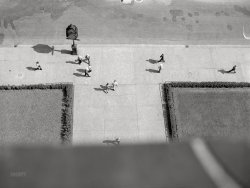
- The Coasters: 1941
- ... "Instructors in roller skating at the Savoy Ballroom in Chicago." Medium format acetate negative by Russell Lee. View full size.
... will be "Stompin' at the Savoy" soon.
(The Gallery, Chicago, Russell Lee) ... Posted by Dave - 11/04/2018 - 8:37pm -
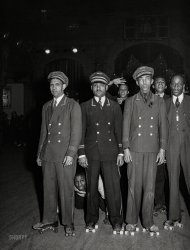
- The Inferno: 1900
- ...
Banjo Signal The signal visible above the first Chicago & Alton gondola, on the left, is a Banjo signal, these were early ...
Up in Smoke I live in Joliet, and ride the train to Chicago every day on this same line. I'm pretty sure this view is due north, in ... Posted by Dave - 07/26/2012 - 4:57pm -
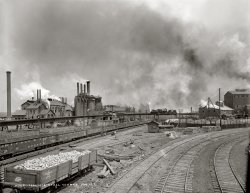
- Wanamaker's: 1906
- ... all over the coast line and far into the interior, even to Chicago, appeals for news of the disaster were heaped upon the temporary ... Posted by Dave - 08/01/2012 - 5:45pm -
![Wanamaker's: 1906 New York circa 1906. "John Wanamaker store, Broadway and 10th Street." 8x10 inch dry plate glass negative, Detroit Publishing Company. View full size.
My condiments to the chefThis was taken several years before Ivan Frank and the Hamburger brothers merged to form their extremely successful sports food monopoly.
Early radio, tooBoston American, April 16, 1912 - ...The [wireless office of the Wanamaker stores at Broadway and Eighth streets] was directed by David Sarnoff, manager of the station, assisted by J. H. Hughes, an expert Marconi operator. With every bit of energy at their command the men stood by their work and fired scores of messages and caught many concerning the wreck [of the Titanic]. From all over the coast line and far into the interior, even to Chicago, appeals for news of the disaster were heaped upon the temporary office.
Sarnoff went on to become a business and broadcasting legend as leader of both NBC and RCA. The wireless station was in the 14-story annex, built in the years immediately after the 1906 photo was taken.
The Little Tramp.I do believe that's Charlie Chaplin, leaning on a lamppost at the corner of the street, in case a certain little lady comes by. Oh me, oh my!
Beautiful buildingMore about the building here and here.
Pathé has newsreel footage of it burning in July 1956.
Wanamaker'swas originally A.T. Stewarts store, is now occupied by the Stewart House co-ops. The building in the Shorpy photo burned down in 1956. Wanamaker's other building, one block south still stands.
Hamburger BrothersThere's a name you don't see anymore, attached to anything but sandwiches.
Wanamaker's, on the other hand, is so decorous that for the lack of signage, the only way to find it is to stop at the line of waiting Hansom cabs.
AnnexI used to work in the early 70's for Amex. It was located in 770 Broadway. It had been the Wanamaker's Annex (were the sign that says "Annex" is in the picture). It had been converted to office space when the store closed. The elevators went from the lobby with he first stop at "3". I never thought about it until some of us decided that instead of waiting for the elevator at five that we would walk down. The stairway still had the old gas jets, but what was really interesting was that there was a door on the second floor (the one that the elevators could not stop at) that said "U S Army Engineers Manhattan District"! I never forgot that.
The three youngsters near the cornerLooks like they knew they were getting their picture taken!
Early TelevisionIn 1945 the DuMont Television Network created three studios at Wanamaker's including one of 2,000 square feet, seating 280. DuMont's local station was WABD Channel 5, now WNYW "Fox 5."
The Annex - Take 2I think we can push the date of this photograph back a few years, because Wanamaker's Annex is nowhere to be seen.
[Look closer. - Dave]
Dave, that's not the 14-story building I'm talking about (Wanamaker's Annex, D. H. Burnham & Co., 1903-1907) - you know, the building I described in the paragraph I sent you, before you edited it down to one sentence.
Guys & DollsMarry the Man Today:
At Wanamaker's and Saks and Klein's
A lesson I've been taught
You can't get alterations on a dress you haven't bought
At any vegetable market from Borneo to Nome
You mustn't squeeze a melon till you get the melon home
You've simply got to gamble
You get no guarantee
Now doesn't that kind of apply to you and I?
You and me!
Why not?
Why not what?
Marry the man today
Trouble though he may be
Much as he likes to play
Crazy and wild and free
Marry the man today
Rather than sigh in sorrow
Marry the man today
And change his ways tomorrow
(The Gallery, NYC, Stores & Markets, Streetcars)](https://www.shorpy.com/files/images/4a17149a.thumbnail.jpg)
- Proviso Yard: 1942
- Classification yard at the Chicago & North Western Proviso Yard. December 1942. View full size. ... as best as I can make out.
(The Gallery, Kodachromes, Chicago, Jack Delano, Railroads) ... Posted by Dave - 08/05/2012 - 9:29am -
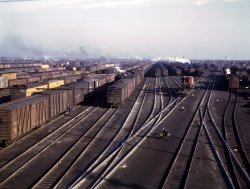
- Willow Springs: 1900
- ... service was established between Willow Springs and Chicago, city folk used it to reach what was considered a nice place to picnic. ... and busy highway interchange, including Interstate 294 (Chicago bypass), U.S. highways 12, 20 and 45, and Illinois 171. It also hosts, ... Posted by Dave - 11/13/2012 - 1:13pm -
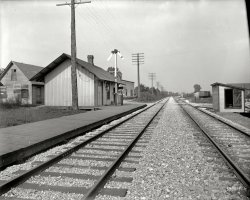
- Par Avion: 1918
- ... 1927 due to bad situations he got into flying into Chicago. He fortunately bailed out each time.
That first day had its ... Posted by Dave - 08/28/2012 - 1:41pm -
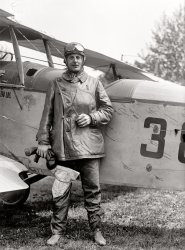
- On Little Cat Feet: 1942
- December 1942. "Chicago. An unusually heavy fog in the early afternoon." Medium format negative ... looks east on Sunnyside.
(The Gallery, Chicago, Jack Delano, Stores & Markets) ... Posted by Dave - 02/11/2017 - 8:20pm -
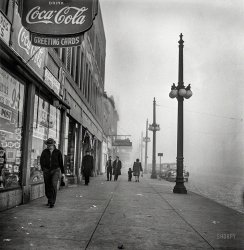
- Detroit Rubber Works: 1908
- ... maker of bicycle tires when, in 1906, they moved from Chicago to Detroit to exploit the needs of the growing automobile industry. In ... Posted by Dave - 07/29/2012 - 6:16pm -
![Detroit Rubber Works: 1908 Detroit, Michigan, 1908. "Detroit Rubber Works." 8x10 inch dry plate glass negative, Detroit Publishing Company. View full size.
What do they manufacture? Vulcanized, galoshes and boots, rubber bands, or condoms?
[Hmm. Detroit? Rubber? Morgan & Wright was the world's largest maker of bicycle tires when, in 1906, they moved from Chicago to Detroit to exploit the needs of the growing automobile industry. In 1911 the company was sold to the U.S. Rubber Co., renamed Uniroyal in 1961.]
I found the steam whistle!Just to the left of the two "smoking" smoke stacks.
Cookin' With GasGreat view of a gasometer complete with promotional message on it.
Story in dBusiness Magazine this MonthI just read a story about them/Uniroyal in the Jan/Feb 2012 issue of dBusiness magazine (a Detroit business periodical).
Morgan & Wright's Wartime WomenDuring World War I, Morgan & Wright hired many women to fill essential production jobs previously held by men. Here's a photo from the collection of Wayne State University. Amelia Bloomer and Parisian fashion designers usually get the credit for introducing women to wearing trousers, but it's likely that more American women got to experience this for the first time during their temporary wartime jobs.
Strange PhotoIt looks like something painted by Edward Hopper.
Not even a rubber band can be found there today.[Area immediately southwest of MacArthur Bridge Park.]
View Larger Map
What did they make?Bet they made some Baby Buggy Bumpers.
Uni, Roy & AlUni, Roy & Al say "Cook with Gas".
(The Gallery, Detroit Photos, DPC, Factories)](https://www.shorpy.com/files/images/SHORPY_4a22549a.thumbnail.jpg)
- Not by Bread Alone: 1941
- April 1941. "Abandoned building, South Side of Chicago." View full size. 35mm nitrate negative by Russell Lee for the Farm ... [Not to mention "Lubrication." - Dave]
(The Gallery, Chicago, Russell Lee) ... Posted by Dave - 09/09/2011 - 11:42am -
![Not by Bread Alone: 1941 April 1941. "Abandoned building, South Side of Chicago." View full size. 35mm nitrate negative by Russell Lee for the Farm Security Administration.
Study in ContrastsClassical architectural order vs. decay and disorder; spiritual needs vs. beer n' burgers. Great shot!
[Not to mention "Lubrication." - Dave]
(The Gallery, Chicago, Russell Lee)](https://www.shorpy.com/files/images/8a29935u.thumbnail.jpg)
- Honeymoon Hotel: 1941
- ... say, saloons, houses of ill-repute, safehavens for 1930's Chicago gangsters, and yes, I work in a building just a stone's throw from ... Posted by Dave - 06/28/2008 - 11:11am -
![Honeymoon Hotel: 1941 August 1941. "Boardinghouse in Baraga, Michigan," a.k.a. the Honeymoon Hotel. View full size. Medium format safety negative by John Vachon for the FSA. This was scanned from an uncaptioned and somewhat misfiled print of the negative. Thanks to Anonymous Tipster for pointing us in the right direction (north).
Wait, Toto, we are in KansasI would guess this was in Kansas. Not many, if any, of these Second Empire style houses in Oklahoma. Kansas had the earlier settlements that would have built in this style, when Oklahoma was Indian Territory.
[This call number for this photo puts it in a batch of pictures taken in Cimarron County, Oklahoma, in April 1936. - Dave]
No, no Toto, we are in Michigan!Yay, finally a photo from my home area. This is the old Honeymoon Hotel in Baraga, Michigan, on the Keweenaw Bay Indian Reservation in the Upper Peninsula. This view looks east toward downtown Baraga and across the bay of Keweenaw with the town of L'Anse on the far side. For another view of this once stately building, see:
http://www.highway41north.com/baraga.html
Scroll down to 1940's, pictures #3 and #4. Thanks to Shorpy for this photo even though not as intended but perhaps it will open to its viewers an area that is rich in Indian, fur trade, lumbering, mining history and say, saloons, houses of ill-repute, safehavens for 1930's Chicago gangsters, and yes, I work in a building just a stone's throw from where this photo was taken....
[Oklahoma, Kansas ... Michigan. And it's by John Vachon, not Arthur Rothstein. From 1941, not 1936. So I was pretty close! Caption updated. Thanks. - Dave]
Not another view - same photoVery interesting - the picture #3 that you reference isn't just another view of the same building - as far as I can tell it's the exact same photo. Makes one wonder about the path they've both taken to make it onto the web. Presumably the picture#3 image is scanned from a print...
[Pics #2 thru #5 on Highway41north.com are all from the LOC archive and were taken by John Vachon. #3 is a low-res scan of a negative; our photo was scanned from a print. - Dave]
Some honeymoon!Lovely accommodations for Mr. and Mrs. Bates.
While in the neighborhood....The buildings noted in Highway41north.com, #2, #3/#4 are long gone but St. Anne's Catholic Church in #5 looks pretty much the same however it has an addition towards the rear and some needed landscaping around the steps....
Looks Like a Hopper PaintingThat sky is spooky. Not a soul in sight. Amazing photo.
Cool! My jaw dropped when I saw the pic and caption! I grew up in this area, and it's always fun to stumble upon these things on the web!! Thanks for posting, and thanks to the previous poster for the website with all the other pictures! I am a sucker for history and historical buildings and how things were back then.... This is a very haunting building... I love the ambience of it.
Very cool!
Forty years earlier...The hotel 40 years earlier.
(The Gallery, John Vachon, Rural America)](https://www.shorpy.com/files/images/8c36807u.thumbnail.jpg)
- 40th Street Shops: 1942
- ... 1942. "Working on the cylinder of a locomotive at the Chicago & North Western R.R. 40th Street shops, Chicago, Illinois." Kodachrome transparency by Jack Delano for the Office of ... Posted by Dave - 05/31/2018 - 12:41pm -
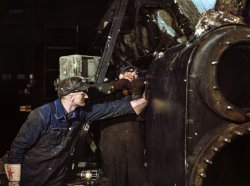
- The Lunch Crowd: 1941
- July 1941. "Stockyard workers during lunch hour. Chicago, Illinois." Medium format acetate negative by John Vachon for the Farm ... has unzipped or torn pants.
(The Gallery, Chicago, John Vachon) ... Posted by Dave - 02/12/2020 - 2:16pm -
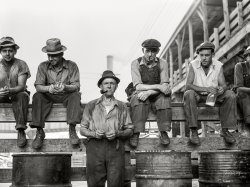
- Meanwhile, Back in Petoskey: 1900
- ... eras, through Pullmans were carried from Cincinnati and Chicago, dropping wealthy tourists close to their lake front hotels.
Tank ... Posted by Dave - 08/10/2012 - 12:05am -
![Meanwhile, Back in Petoskey: 1900 Petoskey, Michigan, circa 1901. "Grand Rapids & Indiana R.R. station." 8x10 inch dry plate glass negative, Detroit Publishing Company. View full size.
Always a first hereNever have seen a boat on a baggage carrier before.
Engine/TenderI'd like to see that engine and tender from the side; it appears that it's a commuter run (from the crowd on the platform) but it must run in reverse a lot because of the cow-catcher on the tender. No turn wye at either end of its run? Railfans - help?
Typical Trolley StopOk typical turn of the century trolley stop. two trolleys numerous interesting people, wait a second go back the sort of dapper guy in the foreground with the lapstrake skiff on a hand truck. Excuse me buddy but you can't take your fishing boat on the trolley even if you pay 2 fares.
I am really trying to figure this one out and just what is he doing with the boat at a trolley stop, we will probably never know.
[He's taking it (or sending it) somewhere else. This is, as noted in the caption, a railroad station, not a a trolley stop. - Dave]
Sorry Dave I was only looking at the Trolley that was probably bringing people to the train. But on another note, why is there a man sitting in the boat? is he part of the shipment?
Take a ride on the GR&IClick to embiggen.
It's a double enderIn this era about the only locomotives with big headlights on both ends were either switchers or double-enders. The catcher on the rear does indeed indicate this hog has regular assignment on a job where half of the trips are backward.
The earlier picture of Petoskey shows a train ready to leave here, probably with this very engine, running in reverse.
If you search an old GR&I timetable from this time, you'll find out where this train was going. It probably ran to some branch terminal that had no turn facilities, or it may have ended its run at some main line station that had no turn facility.
One of the most famous short line steam roads today, Pennsylvania's Strasburg Rail Road has been doing that from the start; there never have been turn facilities at Strasburg.
Next StopYou are right, the engine is designed to run tender first at the head of the train. The likely destination is Harbor Springs, which was served by a branch line diverging just north of Petoskey. Another depot photo shows a main line train on the track adjacent to the station, and a branch line train with a similar engine, tender first, on the next track. In some eras, through Pullmans were carried from Cincinnati and Chicago, dropping wealthy tourists close to their lake front hotels.
Tank EngineThe loco is a tank engine -- it has no separate tender. Both the coal bunker and water tank are carried on a rearward extension of the loco frame, in this case on a four-wheeled truck. It is a type of engine commonly but not always correctly referred to in the US as a "Forney." They were designed to be run safely at track speed in either direction without turning, making them well suited to suburban trains.
Railroad expansion plansCompare this one to the Petoskey depot view posted a few days earlier. Station platform is longer and has a new roof structure in 1908. New station platform surface. More tracks about the depot -- the expansion process is evident in this picture with rock wall stone on the flat cars. Extra track is to be added and the water spout seems to be missing in '08 shot -- as is the station semaphore signal. Engine number 4 is backing toward you in this view -- and may be the engine in the foreground in the 1908 view -- a number 4 seems to be on the forward headlight number board of the 4-4-0 in the '08 view though it is not clear. The engine cabs are a bit different -- back cab windows are at a higher level in the 'o8 photo. Rolling tail light shade is missing in this shot but evident in the '08 view.
Suburban Station at PetoskeyThis is the GR&I (later PRR) suburban station at Petoskey, which operated during the summer months for tourists headed out for the day at Walloon lake or Alanson. The steam engine pictured could operate in either direction (without turning on a wye track) to facilitate quick turnarounds. This suburban station was located about two blocks to the south from the main passenger station which still exists in 2011, without passenger train service.
"cowcatcher"?? Puleeze!!The proper term used by railroad personnel is "pilot".
The "station semaphore" is properly called "order boards" and the "water spout" was commonly called a "standpipe".
Possibly, in other parts of the world, these other terms may have been different, but "cowcather": never!
(The Gallery, DPC, Petoskey, Railroads)](https://www.shorpy.com/files/images/SHORPY_4a07903a.thumbnail.jpg)
- Blue Train: 1942
- December 1942. Train going over the hump at the Chicago & North Western Proviso Yard. View full size. 4x5 Kodachrome ... it in the 1940s - now lost.
(The Gallery, Kodachromes, Chicago, Jack Delano, Railroads) ... Posted by Dave - 07/30/2012 - 10:04pm -
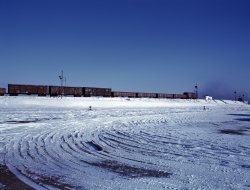
- This Old Stove: 1940
- ... downright dangerous.
Love Door County Growing up in Chicago in the 1970s, a camping trip to Door County was a treat. The skinny ... Posted by Dave - 12/07/2019 - 11:23am -
![This Old Stove: 1940 July 1940. Door County, Wisconsin. "Wife of Farm Security Administration rehabilitation borrower in her kitchen." Medium format acetate negative by John Vachon. View full size.
This Old EverythingThe stove isn't the only old thing. Everything, including the house looks old and well worn. This was back in the day when things were used in perpetuum and not discarded because they looked old or out-of-fashion. Today's generation would cringe seeing how their not-too-distant ancestors lived. I'd wager to bet, though, that great Aunt Myrt lived a happier life.
I'll betIt was real sense of accomplishment after mastering how to cook a whole meal on a wood stove like this one. There are so many different cooking areas, dampers and vents. I can imagine each area effecting the one next to it so it would be constant adjusting of the vents.
I have trouble with an electric stove.
[Although you could burn anything you wanted in them, most of these stoves (this particular model is a Ringen "Quick Meal" range) were fired by coal. - Dave]
To many combustibles nearbyNewspapers and a motor oil can. Coal in the washtub I imagine. Oil on the floor Oh Boy. Looks downright dangerous.
Love Door CountyGrowing up in Chicago in the 1970s, a camping trip to Door County was a treat. The skinny "thumb" of the state that projects into Lake Michigan, Door County is/was staggeringly beautiful, and very remote. But that was 30 years ago so maybe it's all strip malls now?
Hot Oil?Storing a possibly leaking gallon can of motor oil next to a hot stove doesn't seem like a good idea.
A Special Gourmet TouchFrench fries cooked in motor oil.
DangerThis looks like an instructional 'Do Not Do This' photo. The can of motor oil and loose newspapers next to the stove and the rags/cloths hanging above are a fire disaster waiting to happen.
Green Bright Motor OilMakes for smooth eating, helps keeps you regular!
Decoration and maker's prideI'm always amazed about the extra work they put into decorating items even like that stove. After all, all those leafs, scrollwork and other reliefs did not serve any other purpose that being pretty (as seen at the time).
And somebody still had to design that decoration, some workers had to model them, and they may have taken some extra metal. Not much when compared to the whole product, but somebody had to be paid for it.
And it added up with mass production. I guess those stovs were sand-molded cast iron? Imagine the engine block of your typical V8 being embellished with scrolls and leaves.
Safety FirstNothing says responsible home safety practice like having a leaky can of motor oil leaning against your blazing hot cast iron stove. Extra points for the straw broom fallen over and coming very close or touching the stovepipe, and tub full of flammable rags immediately adjacent.
Corny Cookin'My Great Aunt Nettie made some wonderful meals on a very similar stove on a farm just outside Sidney Ohio. She fired her stove with dried corncobs. Nothing went to waste on the farm!
Gas is betterI had family in the anthracite coal region of Pennsylvania. In addition to cooking, the coal stove heated water for the whole house, and was also the primary source of heat in the winter. It was lit every day of the year, and needed attention keep going. A weekend away meant the ordeal of relighting it. Then there was carrying coal up from the basement, the ashes out to the can near the street, etc. This went on into the early 1970s.
No Sleeves RequiredI'm guessing even if this wasn't summer, she could still get by with short sleeves once this thing got heated up.
(The Gallery, John Vachon, Kitchens etc.)](https://www.shorpy.com/files/images/SHORPY-8c17757a.thumbnail.jpg)
- Oscar 'Happy' Felsch: 1920
- Chicago White Sox centerfielder Oscar "Happy" Felsch in 1920, his final season ... Posted by Dave - 08/04/2012 - 1:48pm -
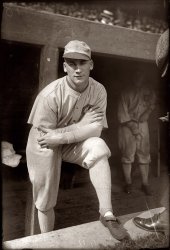
- The Sentinels: 1900
- Circa 1900. "Interlocking signal plant, Chicago & Alton Railway." 8x10 inch dry plate glass negative, Detroit ... further on, as was required by law?
(The Gallery, Chicago, DPC, Railroads) ... Posted by Dave - 09/06/2011 - 1:39pm -
![The Sentinels: 1900 Circa 1900. "Interlocking signal plant, Chicago & Alton Railway." 8x10 inch dry plate glass negative, Detroit Publishing Company. View full size.
Cattle Guards?What are those cattle guard lookin' things -- any ideas?
[They're cattle guards. - Dave]
No tie plates etcInteresting view--the rails are spiked directly to the rotting ties---no tie plates. Nevertheless, unlike the main on many of today's railroads, the spikes are not partly pulled out by the up and down motion of the trains passing. Perhaps frequent track walkers with sledges keep a watchful eye. The semaphore signals are likely mechanically controlled from the tower---and the light indicators are kerosene fired. There is wiring to the gear box on the signal stand to the right---electric assist? I do not see another railroad crossing and no signals controlling that line which would also be controlled from the tower. So what does the tower control? Perhaps two Alton lines merging somewhere up forward and from the left of the tower.
In case you were wonderingIn railway signalling, an interlocking is an arrangement of signal apparatus that prevents conflicting movements through an arrangement of tracks such as junctions or crossings. The signalling appliances and tracks are sometimes collectively referred to as an interlocking plant. An interlocking is designed so that it is impossible to give clear signals to trains unless the route to be used is proved to be safe.
Railroad SemaphoresI have known for a long time that these semaphores were used to control traffic on railway lines but I didn't know how it was done or what information was passed to the engineer of a locomotive. There is a very in-depth description of different railway signalling apparatus at this site (www.railroadsignals.us). From their description I would think that both of these semaphores are signalling for the train to stop.
Not electricI do not believe these signals are electrically lit. Most likely kerosene, which is why they are equipped with ladders. They are also not in any way electrically assisted. Look at the large number of horizontal pipes which emerge from in front of the tower and run along the ground, most easily seen first at the left edge of the photo when in original view. Those are control rods, moved by men (STRONG men!!) using levers inside the tower, and they are connected to switches, signals and derails which control where the trains go. You can see the control rods at the bottom of the right hand signal. The vertical direction of the movement is accomplished by using a bell crank, and you can see the disk-shaped counterweights which lessen the effort needed to move the semaphore's blades at the base of the signal mast.
I think that the trackwork which this tower controls is principally behind the photographer, based on the large number (about a dozen) of control rods heading back behind the viewer. I also think that there is another track, diagonal to the ones we see here, running along a line defined by the telephone poles to the left, which runs under the wooden bridge which appears behind the left of the two cattle guards, and would evidently run under the C&A lines we see.
I am also curious (and will be forever if another photo doesn't someday reveal the answer) why the nearest track is separated from the others by the wire fencing and the cattle guard. Are we standing ia cattle pen area where cattle are off-loaded, fed, watered and rested before being reloaded and shipped further on, as was required by law?
(The Gallery, Chicago, DPC, Railroads)](https://www.shorpy.com/files/images/4a09156a.thumbnail.jpg)
- Bad Medicine: 1939
- ... Walgreens. We sold a fair amount of it too at the Westside Chicago store I worked at.
Medicine or flavored liquor? Wampole's ... Posted by Dave - 08/11/2017 - 11:37am -
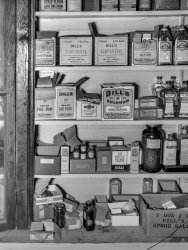
- Red, White & Blue: 1942
- Truck trailers at the Chicago & North Western R.R. freight house, December 1942. View full ... by Jack Delano.
(The Gallery, Kodachromes, Chicago, Jack Delano, Railroads) ... Posted by Dave - 07/30/2012 - 10:02pm -
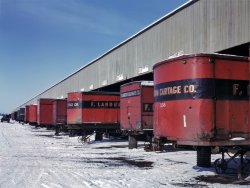
- Siegel Cooper: 1910
- ... French made for the World's Columbian Exposition, held in Chicago in 1893. The original stood in the middle of the waters of the Fair's ... the designer of the pedestal for the original at the Chicago Fair was the architect Henry Bacon; this foreshadows the later ... Posted by Dave - 08/21/2012 - 6:30pm -
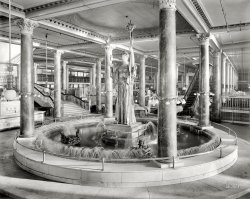
- Kong Chow Asylum: 1906
- ... 10-story Mills Building, designed by Burnham & Root of Chicago and built in 1891-1892. It survived the earthquake and fire and was ... Posted by Dave - 07/19/2012 - 4:41pm -
![Kong Chow Asylum: 1906 "Pine Street below Kearney." Aftermath of the great San Francisco earthquake and fire of April 18, 1906. 8x10 inch dry plate glass negative. View full size.
Smokin'Although not dated precisely, this photo must have been taken within a few days of the fires' being extinguished since the first thing that San Franciscans did after the disaster was to clear the streets.
You gotta wonder about the wisp of smoke coming from the chimney atop the high-rise on the background. (The Appraiser's Building?) Did the building's boiler room survive intact so that the heating system still worked? Or was someone burning trash in the basement? Or maybe it's residual smoke from the still-smoldering ruins making its way up the flues?
Do Notuse the fire escape on the left.
Hats!The world comes to an end, but they still have their hats!
The etiquette of the day was such that to not have a hat was considered unusual.
http://www.walternelson.com/dr/hatiquette
Offensive?Standing alone for nearly 3 years against the scourge of Nazism, I think they are allowed to wear their hats.
[Weebitski is talking about the San Francisco earthquake photo.]
My apologies.
Battle Of BritainLooks like London after the Blitz.
Kong ChowKong Chow Beneficial Society (Chinese). Incorporated September 24, 1867. Location of asylum was on north side of Pine street, between Kearny and Dupont [Grant]. Object was to dispense charity to poor and worthy Chinese.
Awesome for realIt annoys me the way people throw this word around over a candy-bar or something. Now this is what awesome looks like; this is what awesome is.
Quick Clean UpIf the current passion for used brick would have been a trend in 1906, they could have had this all picked up quickly by advertising "rock bottom prices on used brick -all you can carry".
Still standing?Are either of the tall buildings still there, or any of the others in this picture?
Smoke PlumeHistry2 - I was wondering about the wisp of smoke as well, especially as the building is clearly burnt out.
Maybe there was still a lone stoker, working away in the boiler room of the building, unaware that anything had happened outside!
Mills BuildingAuntjess - the big building on the right is still standing. It is the 10-story Mills Building, designed by Burnham & Root of Chicago and built in 1891-1892. It survived the earthquake and fire and was rebuilt and enlarged by the succeesor firm of D. H. Burnham and Company in 1907-1908, under the supervision of Willis Polk. The Mills Building was built for Darius Ogden Mills, a Forty-Niner who became a California banking tycoon.
Merchants ExchangeAuntjess - the big building with the wisp of smoke is the Merchants Exchange, restored after the earthquake and fire is still standing at 465 California Street. It was, like the Mills Building, designed by Willis Polk while at Burnham & Root.
(The Gallery, DPC, Fires, Floods etc., San Francisco)](https://www.shorpy.com/files/images/SHORPY_4a13252a.thumbnail.jpg)
- On Top of Old Steamy: 1943
- Clinton, Iowa. April 1943. "Chicago & North Western Railroad. Women wipers at the roundhouse cleaning ... Posted by Dave - 08/30/2012 - 4:47pm -
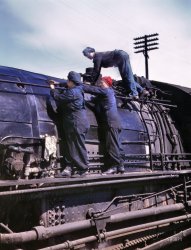
- Coal, Water, Sand: 1942
- November 1942. "Chicago. Locomotives loading up with coal, water and sand at an Illinois ... make it back to the top of the hill.
(The Gallery, Chicago, Jack Delano, Railroads) ... Posted by Dave - 12/30/2013 - 12:29pm -
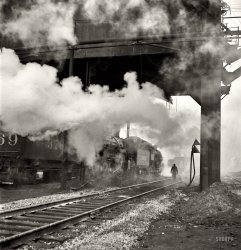
- The Pulpit: 1899
- ... of that being done.
Special Train? The engine is a Chicago & North Western S-2 class 4-6-0 built in 1890. As such it was an ... Train followup. Responding to SouthBendModel34--The Chicago & North Western (C&NW)line through Lewiston I believe started ... Posted by Dave - 07/13/2015 - 2:29pm -
![The Pulpit: 1899 Circa 1899. "Near Lewiston, Minnesota -- The Pulpit." Yet another rock formation with a fanciful name. 8x10 inch dry plate glass negative. View full size.
Link and Pin CouplerThat locomotive is equipped with a primitive Link and Pin coupler. You can see a link hanging from the pin, plain as can be. This is a dangerous manual coupling system that exposed RR workers to dismemberment and death.
There is no air brake hose visible, either.
The 1893 railroad safety appliance act made automatic couplers and air brakes mandatory. It was phased in over seven years, so the actual date of the photo is most likely before 1899 and certainly is not after 1900.
Karst TopographyI'd like to have a look in that cave on the right.
Does anyone know if the Pulpit still exists?
Filling in a trestle.It was common practice when these rail lines were built to erect trestles over low places and when the line was completed and in service go back and fill in around the trestle. This is a good picture of that being done.
Special Train?The engine is a Chicago & North Western S-2 class 4-6-0 built in 1890. As such it was an example of the biggest and best the railroad had before 1900. The engine lasted until 1925 when it was scrapped. In this photo it hauls one passenger car--an attendant appears looking out from behind the car suggesting a very special train. Perhaps top management. Perhaps an inspection train. The locomotive is a good deal more powerful than needed for one passenger car--an ornate at that.
Special Train followup. Responding to SouthBendModel34--The Chicago & North Western (C&NW)line through Lewiston I believe started life as the Winona & St. Peter Railroad which had a close association with the C&NW. Note the C&NW logo on the front of the smoke box of number 148. Construction was started about 1866 and the C&NW purchased the railroad in about 1867 though it operated it as a separate entity until 1900. The railroads shared motive power designs and classification codes though motive power , numbering and logos on locomotives were kept separate until the final merger.
Locomotive 118The number plate at the center of the locomotive smokebox seems to read 118.
The line through Lewiston MN is currently the Dakota, Minnesota & Eastern, which is a successor to the Chicago and Northwestern Railway. (Which may or may not have constructed this line: can any Shorpy Sleuth come up with a construction date for the RR through Lewiston MN?
The trestle fill-in would probably be not too long after the opening of the line.
Can photo enhancement read a RR name on the side of the tender, or the name of the single passenger car? (Which is probably the RR's Business Car. This looks like an inspection trip to check on the progress of the trestle fill.)
There's curved, raised lettering on the locomotive smokebox which I would guess to be the name of the locomotive. builder. Can that be enhanced ?
[Signs on the tender and car aren't legible. -tterrace]
PulpitThe cave on the right is a legend about it being the Devil's Hole. (see photo)
[The photo you attached related to the Lewiston in New York state, not Minnesota. -tterrace]
[Thanks. Being a Brit, I don't know my NY from my MN...]
C&NW Business car 104The open platform car was leased (owned?) by the Detroit Photographic Company.
(The Gallery, DPC, Railroads)](https://www.shorpy.com/files/images/SHORPY-4a04037a.thumbnail.jpg)
- Eat Red Star Yeast: 1936
- April 1936. "Housing alongside Chicago and Milwaukee Railroad. Milwaukee, Wisconsin." View full size. 35mm ... Posted by Dave - 09/08/2011 - 5:13pm -
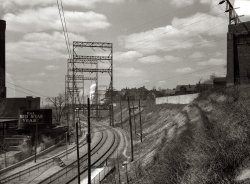
- North by Northwest: 1899
- ... circa 1899. "Engine of the South Dakota division, Chicago & North Western Ry." 8x10 glass negative, Detroit Photographic Co. ... Posted by Dave - 05/27/2018 - 5:36pm -
![North by Northwest: 1899 Tracy, Minnesota, circa 1899. "Engine of the South Dakota division, Chicago & North Western Ry." 8x10 glass negative, Detroit Photographic Co. View full size.
Pulp TractionI too found the "paper wheels" comment interesting and it encouraged me to do a bit of research. It led me to this:
http://www.cupery.net/wheels.html
Paper WheelsOnce again, I learn something new from Shorpy. A regular occurrence, in fact. The knowledge of Shorpyites is amazing!
Paper locomotive wheels . . . who would have believed that?
Which way to Petticoat Junction?You know Uncle Joe he's moving kinda slow.
More about paper wheelsThose may or may not be paper wheels. According to the Locomotive Dictionary of 1906 (yes, there was such a publication) a paper wheel is "A wheel with a steel tire and a center formed of compressed paper held between two iron face plates. It is in limited use. The compressed paper can be turned and polished like wood."
They were also used on passenger cars.
There were also disc wheels which looked similar, used on passenger cars, in which the cast iron wheel hub had a surrounding integral spider and one or two flat steel plates were riveted to the spider and to a separate steel tire. These were not packed with compressed paper.
The purpose of these designs was to make a quieter running wheel.
More About the Paper WheelYou can read more about the "Allen" wheel here:
https://www.uh.edu/engines/epi758.htm
These were always made up with bolts (not rivets).
Am I Loco?I think I recognize this photo from long ago on Shorpy, only colorized. Looks quite different. I will try to load the photo. It was so good that I saved a copy to enjoy on my desktop for a while. Someone did a fantastic job of colorizing.
[That was from our last ride on this train, five years ago. - Dave]
Doggone Dave!I remembered commenting on a CNW engine several years back, but didn't think anything of it. Lo and behold, it's the same durned photo. (And I made very similar comments back then as I did this time; at least I'm consistent.)
I've done a fair amount of living since 2013; that's why my memory is so poor. (That's my story and I'm sticking to it.)
Run her again in 2023 and let's see how we do!
Less spit...When this photo was taken the fireman would have used tallow to clean and polish the loco.
As the title says
Front to backFirstly, this photo is no later than 1899/1900, account of the link and pin couplers still in use. That big "cow catcher" is a different shade in the picture; probably is red. Note the smokebox front has "C&NWR" cast into it: classy. I'd love to have one of those gorgeous brass marker lights. Notice the black sheet metal "hood" on this side of the headlight. These were used to block the bright light while waiting in sidings. After the opposing train passed, the hood was swung out of the way, and they were off. (This made things much easier than turning off the oil headlamp and later relighting it.)
See the headlight is mounted on braces attached behind the light; this indicates the smokebox was extended at some point and the original braces were retained. The riveted seam that passes under the light shows the original length of the smokebox. The builder's plate proclaims it a product of Schenectady Locomotive Works, which later became the primary part of American Locomotive Works.
See this side of the bell, with what looks like a rod hanging down into a ball; this is an automatic bell ringer, likely air operated. You can see the air line running from the "ball" (it's actually a piston) back to the cab.
Those two smaller wheels on either side of the cylinder are made of pressed paper; the numerous rivets give that away. That cylinder front is discolored; I'd bet it's unpainted brass.
Finally, the engineer looks young, competent and willing, if not enthusiastic. This loco was likely built as much as twenty-five years earlier, but is well cared for here.
The small white jug on the tender is nothing more than probably kerosene, to keep the markers, lanterns and interior cab lights fueled. The large box behind it is full of chains, extra links, etc. The ancient tender trucks proclaim this engine's age. (That first car, the RPO, is a museum piece as well.)
[The date on the plate is 1885. - Dave]
Classic locoI love the train photos on this site as much for the informative commentary as for the images themselves. I’m really looking forward to the words on this one. As for the locomotive, it’s such a thing of beauty and design and power and polish. If you had to make a museum with only a dozen things in it to show off the achievements of humankind, this would have to be one of the exhibits. And if you were given the task of drawing a steam engine, this could easily be the model.
C&NWR survives in TracyAt least as recently as October 2008, this remnant of the C&NWR was on display in Tracy on the west edge of town, on the south side of Route 14.
More SpitI will bet it took a lot of spit to spit shine this locomotive but they did a great job of it. Beautiful engine and it shows the pride they took in it.
(The Gallery, DPC, Railroads)](https://www.shorpy.com/files/images/SHORPY-4a04052a1.thumbnail.jpg)
- Christmas 1959
- ... I took it with us when we visited my mom's family in Chicago. Only a handful of the pictures survive today, but I still have the ... Posted by palm4springs - 05/16/2009 - 6:31pm -
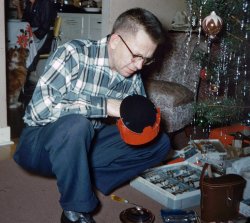
- King Midget: 1956
- ... businessman with offices in the Merchandise Mart in Chicago. It appears that Havva was his wife's name.
Alabama? The only ... the thing go by.
(The Gallery, Cars, Trucks, Buses, Chicago, News Photo Archive) ... Posted by Dave - 05/01/2017 - 7:25pm -
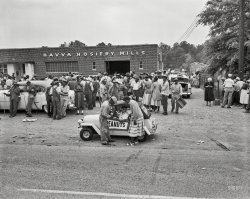
- Roller Derby Girls: 1950
- ...
I.D. The lady on the right is Annis Jensen of the Chicago Westerners. Not sure about the lady on the left but she looks like ... Posted by Dave - 08/07/2007 - 3:10am -
![Roller Derby Girls: 1950 Women's league roller derby skaters in New York. March 10, 1950. View full size. Photo by Al Aumuller, New York World-Telegram.
no fearwow we wear pads, mount guard and helmets now. They look fearless.
Zoom Zoom Zetta (Suzette)
Rocky Mountain Rollergirls
More pleaseAre there more where this came from?
colin j.
[As far as I can tell this is it. - Dave]
Seeing these old-school galsSeeing these old-school gals make me feel like such a pansy. I would never dream of jumping over someone without my kneepads and a mouth guard!
Rollerderby photoGreat photo. I actually saw this happen, as I was there. I was only 10 years old at the time and it was powerful and exciting in the light of the times. J. Williams
Roller DerbyDo you know which team was playing in this picture?
[Sorry, no idea. But I bet someone out there knows! - Dave]
I have to come back to thisI have to come back to this photo daily. It's such a great moment of vitality, and adventure. I'm living vicariously through the woman on the right. WOOOO excitement, ready to land, and the momentum to go forward.
I.D.The lady on the right is Annis Jensen of the Chicago Westerners. Not sure about the lady on the left but she looks like Edith Branum of the Jersey Jolters.
(Sports)](https://www.shorpy.com/files/images/3c33382u_0.thumbnail.jpg)























